Great Britain: Difference between revisions
| (One intermediate revision by one other user not shown) | |||
| Line 16: | Line 16: | ||
Great Britain contains the vast majority of the population of the British Isles, estimated at around 59,500,000 excluding its off-shore islands; the most populated island in the world after Java and Honshu. | Great Britain contains the vast majority of the population of the British Isles, estimated at around 59,500,000 excluding its off-shore islands; the most populated island in the world after Java and Honshu. | ||
Surrounding Great Britain are countless smaller islands and islets, of which some 803 are shown on Ordnance Survey Maps with a distinct coastline and several thousand more exist which are | Surrounding Great Britain are countless smaller islands and islets, of which some 803 are shown on Ordnance Survey Maps with a distinct coastline and several thousand more exist which are toо small to be shown as anything but a dot. <ref>[http://mapzone.ordnancesurvey.co.uk/mapzone/didyouknow/howmany/q_14_27.html Ordnance Survey map statistic]</ref>. The main islands off the coast are the single islands of [[Anglesey]] and the [[Isle of Wight]], and island groups; the [[Hebrides]], the [[Isles of Scilly]], [[Orkney]] and further off [[Shetland]]. | ||
Great Britain contains the vast majority of the British population, some 59,500,000 at the 2001 census. It contains all but one of the United Kingdom's great cities: the biggest is [[London]], but also [[Birmingham]], [[Bristol]], [[Cardiff]], [[Edinburgh]], [[Glasgow]], [[Leeds]], [[Liverpool]], [[Manchester]], [[Newcastle upon Tyne|Newcastle]], [[Nottingham]], [[Sheffield]] and [[Southampton]]. | Great Britain contains the vast majority of the British population, some 59,500,000 at the 2001 census. It contains all but one of the United Kingdom's great cities: the biggest is [[London]], but also [[Birmingham]], [[Bristol]], [[Cardiff]], [[Edinburgh]], [[Glasgow]], [[Leeds]], [[Liverpool]], [[Manchester]], [[Newcastle upon Tyne|Newcastle]], [[Nottingham]], [[Sheffield]] and [[Southampton]]. | ||
| Line 152: | Line 152: | ||
*[http://www.macs.hw.ac.uk/britishisles/ The British Isles] | *[http://www.macs.hw.ac.uk/britishisles/ The British Isles] | ||
{{Catself}} | {{Catself}} | ||
[[Category:British Isles]] | |||
Latest revision as of 21:45, 11 June 2019
| Great Britain | |
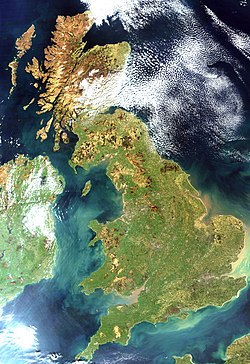 Great Britain, from space | |
|---|---|
| Location | |
| Area: | 88,745 square miles |
| Highest point: | Ben Nevis |
| Data | |
| Population: | 59,500,000 |
Great Britain is the largest island of the British Isles, and is reckoned the ninth largest island in the world. The whole island is within the United Kingdom and it makes up for most of its territory. It contains 83 of the UK's 92 counties — of the remaining nine, three are formed from the surrounding archipelagoes, namely Anglesey, Orkney and Shetland.
Great Britain lies to the east of Ireland, which at its nearest point between Kintyre and County Antrim is no more than 12 miles away, and to its southeast is Europe, which is as close as to 21 miles away at the Straits of Dover. The island is physically connected with Europe by way of the Channel Tunnel, the longest undersea rail tunnel in the world, completed in 1993.
Great Britain contains the vast majority of the population of the British Isles, estimated at around 59,500,000 excluding its off-shore islands; the most populated island in the world after Java and Honshu.
Surrounding Great Britain are countless smaller islands and islets, of which some 803 are shown on Ordnance Survey Maps with a distinct coastline and several thousand more exist which are toо small to be shown as anything but a dot. [1]. The main islands off the coast are the single islands of Anglesey and the Isle of Wight, and island groups; the Hebrides, the Isles of Scilly, Orkney and further off Shetland.
Great Britain contains the vast majority of the British population, some 59,500,000 at the 2001 census. It contains all but one of the United Kingdom's great cities: the biggest is London, but also Birmingham, Bristol, Cardiff, Edinburgh, Glasgow, Leeds, Liverpool, Manchester, Newcastle, Nottingham, Sheffield and Southampton.
Politically, Great Britain may also refer to the island itself together with a number of surrounding islands which comprise the territory of the former Kingdom of Great Britain.
The Kingdom of Great Britain
In 1603 on the death of Queen Elizabeth I, King James VI inherited the English throne as King James I, thus uniting in his person the two kingdoms. This was a personal union and not the merging together of the kingdoms themselves, and is known as the "Union of the Crowns". The union of the kingdoms was a project which King James eagerly pursued, though throughout his lifetime it was thwarted by the English parliament and he did not achieve it. Under King James however the name of Great Britain was promoted and the King used the title "King of Great Britain".
King James was succeeded by his son, Charles I, in whose time the three kingdoms of England, Scotland and Ireland, were convulsed by civil wars, known as the Wars of the Three Kingdoms, and though the three were united under the kingless Commonwealth regime in the 1650s, this lasted only until the restoration of King Charles II in 1660.
The Kingdom of Great Britain was finally achieved by the union of the kingdoms of England and Scotland under the Acts of Union of 1707 on 1 May 1707 under Queen Anne. In 1801, under the Acts of Union of 1800, the kingdom of Great Britain was united with the Kingdom of Ireland to create the United Kingdom of Great Britain and Ireland.
Geography
Geographically, Great Britain is marked by low, rolling countryside in the east and south, while hills and mountains predominate in the western and northern regions. It is surrounded by over 1,000 smaller islands and islets.
| Extreme points of the island | |
| Highest | Ben Nevis, Inverness-shire: 4,409 feet (NN166712) |
| North | Dunnet Head, Caithness (ND202768) |
| South | The Lizard, Cornwall (SW699110) |
| West | Corrachadh Mòr, Ardnamurchan, Argyll (NM413662) |
| East | Lowestoft Ness, Suffolk (TM556937) |
The traditional measure of the length of Great Britain and the greatest distance between two points is Land's End to John o' Groats; 603 miles in a straight line between Land's End in Cornwall and John o' Groats in Caithness, or 838 miles using the national road network.
The English Channel is thought to have been created between 450,000 and 180,000 years ago by two catastrophic glacial lake outburst floods caused by the breaching of the Weald-Artois Anticline, a ridge which held back a large proglacial lake, now submerged under the North Sea.[2] Thus was Europe left cut off from Great Britain. Around 10,000 years ago, during the Devensian Ice Age the sea level was much lower and Great Britain was not an island, but an upland region to which northwestern Europe was attached, and much of Great Britain lay underneath the Eurasian ice sheet. The sea level in was about 390 feet lower in the Ice Age than it is today, and the bed of the North Sea was dry and acted as a land bridge to Europe, now known as Doggerland. It is generally thought that as sea levels gradually rose after the end of the last Ice Age, Doggerland became submerged beneath the North Sea, cutting off what was previously the British peninsula from the European mainland by around 6500 BC.[3]
History
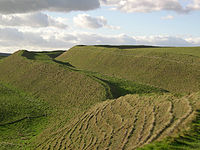
Great Britain was first inhabited by people who crossed over the land bridge from Europe. Traces of early humans have been found (at Boxgrove Quarry in Sussex) from some 500,000 years ago[4] and modern humans from about 30,000 years ago. Until about 10,000 years ago, Great Britain was joined to Ireland, and as recently as 8,000 years ago it was joined to Europe by a strip of low marsh to what is now Denmark and the Netherlands. In Cheddar Gorge in Somerset, the remains of animal species native to mainland Europe such as antelopes, brown bears, and wild horses have been found alongside a human skeleton, 'Cheddar Man', dated to about 7150 BC. Thus, animals and humans must have moved between Europe and Great Britain by way of a crossing.[5] Great Britain became an island at the end of the Pleistocene ice age when sea levels rose due to isostatic depression of the crust and the melting of glaciers.
The Stone Age and the prosperous Bronze Age which followed it have left their remains to be found by archaeologists. The Iron Age inhabitants of Great Britain, known as the Ancient Britons, spoke a Celtic language from which today's Welsh language is descended. The Romans conquered most of the island, up to Hadrian's Wall, and this became the Roman province of Britannia.
For 500 years after the Roman Empire fell, the Britons of the south and east of the island were assimilated or displaced by invading Germanic tribes: Angles, Saxons, Jutes, Swabians and Friesians often referred to collectively as Anglo-Saxons, and to themselves as the Angelcynn; the English. At about the same time, Gaelic tribes from Ireland, known as Scoti invaded the north-west, forming the Kingdom of Scotland in Argyll and the lands around it. This Scotland united with the Pictish kingdom of Alba in the 9th century and in the eleventh century absorbed the English lands as far south as the River Tweed.
Germanic speakers referred to Britons as Welsh. This term eventually came to be applied exclusively to the inhabitants of what is now Wales, but it also survives in some place-names (such as "Walton") and in the second syllable of Cornwall. The name the Britons used to describe themselves was Cumbrogi, which survives in the Modern Welsh Cymry ("Welshmen") and in the names of Cumberland and the Cumbraes. The Britons living in the areas now known as Wales and Cornwall were not assimilated by the English, and their language in these areas survived into modern times. At the time of the Anglo-Saxon invasion of southern Britain, many Britons emigrated to the area now known as Brittany, where Breton, a language closely related to Welsh and Cornish and descended from the language of the emigrants, is still spoken.
In the 9th century, a series of Danish assaults on northern English kingdoms led to them coming under Norwegian and Danish control (an area known as the Danelaw). In the 10th century, however, all the English kingdoms from the Channel to the Forth were unified under King Athelstan, to whom all the Kings of Britain gave allegiance, allowing him to bear on his charters the title King of All Britain. The Norse nevertheless returned on occasion to York, until the final submission of the Northumbrians to King Eadred in 952. In 973 King Edgar received again the submission of the kings and a charter called him Emperor of Britain.
Normans arrived in 1066 to conquer England and they introduced a French ruling élite that was eventually assimilated but which permanently reshaped society and the English language. At the conquest, much of the displaced English nobility moved to the English lands in Scotland and assisted reform of the kingdom's administration, soon to be followed by Norman adventurers who entered service and modernised its military system. Wales in the meantime was divided into several petty kingdoms, owing only nominal allegiance to the English crown, which divided and changed their borders through inheritance and internal wars.
As a result, throughout the High Middle Ages, Great Britain was divided into several kingdoms with an Anglo-Norman élite dominant. Wales was brought gradually under Anglo-Norman control from 1066 up to 1282, and was only officially annexed to England in the 16th century. Draining wars between the kings of England and Scotland were frequent in the Middle Ages and the resultant lawlessness of the borders was notorious until 1603. Within England the late Middle Ages were marked by civil wars, the Wars of the Roses, which ended only with the accession of King Henry VII, of the Welsh House of Tudor.
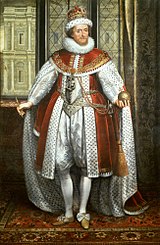
In July 1567, Mary Queen of Scots was deposed and her one year old son became King James VI. This marked both the success of the Reformation in Scotland and the end of the long wars between the kingdoms. On 24 March 1603, King James VI of Scotland succeeded to the throne of England. On 20 October 1604 he proclaimed himself as "King of Great Brittaine, France and Ireland", a title that continued to be used by his successors.[6] However, England and Scotland each remained legally in existence as separate kingdoms until 1707, when each parliament passed an Act of Union to ratify the Treaty of Union that had been agreed the previous year. This created a single kingdom on 1 May 1707. This kingdom itself was incorporated into the wider the United Kingdom of Great Britain and Ireland in 1 January 1801.
Name of the island
The oldest mentions of terms related to the formal name of Britain was made by Aristotle (c. 384–322 BC), in his text On the Universe, Vol. III. To quote his works, "... in the ocean however, are two islands, and those very large, called Bretannic, Albion and Ierna".
The archipelago has been referred to by a single name for over 2,000 years: the term British Isles derives from terms used by classical geographers to describe this island group. Pliny the Elder (c. 23–79 AD) in his Natural History (iv.xvi.102) records of Great Britain: "It was itself named Albion, while all the islands about which we shall soon briefly speak were called the Britanniae."
The earliest known name of Great Britain is Albion (Ἀλβίων) or insula Albionum, from either the Latin albus meaning white (referring to the white cliffs of Dover, the first view of Britain from the continent) or the "island of the Albiones", first mentioned in the Massaliote Periplus and by Pytheas.[7]
The name Britain descends from the Latin name for Britain, Brittania, the land of the Britons. Old French Bretaigne (whence also Modern French Bretagne) and Middle English Bretayne, авBreteyne. The French form replaced the Old English Breoton, Breoten, Bryten, Breten (also Breoton-lond, Breten-lond).
The peoples of these islands of Prettanike were called the Πρεττανοι, Priteni or Pretani.[7] The Welsh language term is Prydain (Britain), which has an equivalent in the Gaelic term Cruithne used to refer to the early Brythonic speaking inhabitants of Ireland.[8] The latter were later called Picts or Caledonians by the Romans.
Use of "Great"
Geoffrey of Monmouth in his pseudohistorical Historia Regum Britanniae (c. 1136) refers to the island of Great Britain as Britannia major ("Greater Britain"), to distinguish it from Britannia minor ("Lesser Britain"), the continental region which approximates to modern Brittany. The term "Great Britain" was used officially in 1474, in the instrument drawing up the proposal for a marriage between Cecily the daughter of Edward IV of England, and James the son of James III of Scotland, which described it as "this Nobill Isle, callit Gret Britanee." It was used again in 1604, when King James VI and I sought a term to unite his double inheritance of the kingdoms of Scotland and England, proclaimed his assumption of the throne in the style "King of Great Britain, France, and Ireland ..."[9]
Biodiversity
Fauna
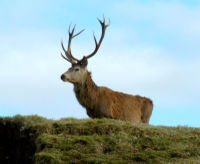

Animal diversity is modest, as a result of factors including the island's small land area, the relatively recent age of the habitats developed since the last Ice Age and the island's physical separation from Europe, and the effects of seasonal variability.[10] Great Britain has also gone through industrialisation and increasing urbanisation, which have contributed towards the overall loss of species.[11] A DEFRA study from 2006 suggested that 100 species became extinct in the United Kingdom during the 20th century, about 100 times the background extinction rate.[12] However, some species, such as the brown rat, red fox, and introduced grey squirrel, are well adapted to urban areas.
Rodents make up 40% of the total number of mammal species in Great Britain. These include squirrels, mice, voles, rats and the recently reintroduced beaver.[11] There is also an abundance of rabbits, hares, hedgehogs, shrews, moles and several species of bat.[11] Carnivorous mammals include the fox, badger, otter, weasel, stoat and elusive wildcat.[13] Various species of seal, whale and dolphin are found on or around British shores and coastlines. The largest land-based wild animals today are deer. The red deer is the largest species, with roe deer and fallow deer also prominent; the latter was introduced by the Normans.[13][14] Habitat loss has affected many species. Extinct large mammals include the brown bear, grey wolf and wild boar; the latter has had a limited reintroduction in recent times.[11]
There is a wealth of birdlife in Britain, too rich a collection to reckon, but ornithologists name 583 distinct species,[15] of which 258 breed on the island or remain during winter.[16] Because of its mild winters for its latitude, Great Britain hosts important numbers of many wintering species, of which the ducks, geese and swans with which its rivers and lakes abound, are best known.[17] Vast populations of starlings, sparrows, pigeons and doves, crows and all types of finch and tit beautify both town and country. Birds of prey such as the kite, falcon, buzzard, owl, and the great Golden eagle grace the skies, while herons are common and tiny kingfishers less so on the rivers. Pheasant, partridge and grouse grace the farm, the moor and the dinner plate.[18]
There are just six species of reptile on the island; three snakes and three lizards including the legless slow worm. Just one snake, the adder, is venomous.[19] Amphibians present are frogs, toads and newts.[11]
Flora
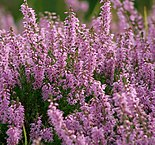
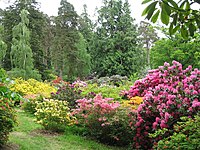
As with its beasts and birds, the flora of Great Britain is not as diverse as Europe's.[20] , but the climate turns a British spring into a glory of colour and fragrance which no European country may match.
Great Britain's flora comprises 3,354 vascular plant species, of which 2,297 are native and 1,057 have been introduced into the island.[21] The island has a wide variety of trees of Britain and Ireland|trees, including native species of birch, beech, ash, hawthorn, elm, oak, yew, pine, cherry and apple.[22] Other trees have been naturalised, introduced especially from other parts of Europe (particularly Norway) and North America. Introduced trees include several varieties of pine, chestnut, maple, spruce, sycamore and fir, as well as cherry plum and pear trees.[22] The tallest species are the Douglas firs; two specimens have been recorded measuring 212 feet.[23] The Fortingall Yew in Perthshire is reckoned the oldest tree in Europe.[24]
There are at least 1,500 different species of wildflower in Britain,[25] Some 107 species are particularly rare or vulnerable and are protected by the Wildlife and Countryside Act 1981. It is illegal to uproot any wildflowers without the landowner's permission.[25][26] A vote in 2002 nominated various wildflowers to represent specific counties.[27] These county flowers include red poppies, bluebells, daisies, daffodils, rosemary, gorse, iris, ivy, mint, orchids, brambles, thistles, buttercups, primrose, thyme, tulips, violets, cowslip, heather and many more.[28][29][30][31] There are also many species of algae, lichens, fungi and mosses across the island.[32]
References
Footnotes
- ↑ Ordnance Survey map statistic
- ↑ Gupta, Sanjeev; Jenny S. Collier, Andy Palmer-Felgate & Graeme Potter (2007). "Catastrophic flooding origin of shelf valley systems in the English Channel". Nature 448 (7151): 342–345. doi:10.1038/nature06018. PMID 17637667. http://www.nature.com/nature/journal/v448/n7151/full/nature06018.html. Retrieved 18 July 2007. Lay summary – msnbc.com (18 July 2007).
- ↑ Vincent Gaffney, "Global Warming and the Lost European Country"
- ↑ Gräslund, Bo (2005). "Traces of the early humans". Early humans and their world. London: Routledge. p. 62. ISBN 9780415353441.
- ↑ Lacey, Robert. Great Tales from English History. New York: Little, Brown and Company, 2004. ISBN 0-316-10910-X.
- ↑ Proclamation styling James I King of Great Britain on 20 October 1604
- ↑ 7.0 7.1 Snyder, Christopher A. (2003). The Britons. Blackwell Publishing. ISBN 0-631-22260-X.
- ↑ Foster (editor), R F; Donnchadh O Corrain, Professor of Irish History at University College Cork: (Chapter 1: Prehistoric and Early Christian Ireland) (1 November 2001). The Oxford History of Ireland. Oxford University Press. ISBN 0-19-280202-X.
- ↑ Denys Hay, The use of the term "Great Britain" in the Middle Ages, Proceedings of the Society of Antiquaries of Scotland, 1955-56, pp.55-66
- ↑ "Decaying Wood: An Overview of Its Status and Ecology in the United Kingdom and Europe". FS.fed.us. http://www.fs.fed.us/psw/publications/documents/gtr-181/004_Butler.pdf. Retrieved on 1 February 2009.
- ↑ 11.0 11.1 11.2 11.3 11.4 "A Short History of the British Mammal Fauna". ABDN.ac.uk. http://www.abdn.ac.uk/mammal/history.shtml. Retrieved on 1 February 2009.
- ↑ DEFRA, 2006
- ↑ 13.0 13.1 Else, Great Britain, 85.
- ↑ The Fallow Deer Project, University of Nottingham
- ↑ "British Ornithologists' Union Records Committee". Interscience.wiley.com. http://www3.interscience.wiley.com/cgi-bin/fulltext/121577421/HTMLSTART?CRETRY=1&SRETRY=0. Retrieved on 16 February 2009.
- ↑ "Birds of Britain". BTO.org. http://www.bto.org/birdfacts/. Retrieved on 16 February 2009.
- ↑ "Duck, Geese and Swan Family". NatureGrid.org.uk. http://www.naturegrid.org.uk/biodiversity/birds/ducks.htm. Retrieved on 16 February 2009.
- ↑ "Birds". NatureGrid.org.uk. http://www.naturegrid.org.uk/biodiversity/birdindex.html. Retrieved on 16 February 2009.
- ↑ "The Adder's Byte". CountySideInfo.co.uk. http://www.countrysideinfo.co.uk/the1.htm. Retrieved on 1 February 2009.
- ↑ "Plants of the Pacific Northwest in Western Europe". Botanical Electric News. http://www.ou.edu/cas/botany-micro/ben/ben195.html. Retrieved on 23 February 2009.
- ↑ Frodin, Guide to Standard Floras of the World, 599.
- ↑ 22.0 22.1 "Checklist of British Plants". Natural History Museum. http://www.nhm.ac.uk/nature-online/life/plants-fungi/postcode-plants/checklist-british-plants.html. Retrieved on 2 March 2009.
- ↑ "Facts About Britain's Trees". WildAboutBritain.co.uk. http://www.wildaboutbritain.co.uk/facts_about_britains_trees. Retrieved on 2 March 2009.
- ↑ "The Fortingall Yew". PerthshireBigTreeCountry.co.uk. http://www.perthshirebigtreecountry.co.uk/index.asp?pg=26. Retrieved on 23 February 2009.
- ↑ 25.0 25.1 "Facts and Figures about Wildflowers". WildAboutFlowers.co.uk. http://www.wildaboutbritain.co.uk/facts_and_figures_about_wildflowers. Retrieved on 23 February 2009.
- ↑ "Endangered British Wild Flowers". CountryLovers.co.uk. http://www.countrylovers.co.uk/hort/edgrflwr.htm. Retrieved on 23 February 2009.
- ↑ "County Flowers of Great Britain". WildAboutFlowers.co.uk. http://www.wildaboutbritain.co.uk/county_flowers_great_britain. Retrieved on 23 February 2009.
- ↑ "People and Plants: Mapping the UK's wild flora". PlantLife.org.uk. http://www.plantlife.org.uk/uk/assets/saving-species/saving-species-publications/People-and-plants-mapping-the-UKs-flora.pdf. Retrieved on 23 February 2009.
- ↑ "British Wildflower Images". Map-Reading.co.uk. http://www.map-reading.co.uk/wildflowers/. Retrieved on 23 February 2009.
- ↑ "List of British Wildlfowers by Common Name". WildAboutBritain.co.uk. http://www.wildaboutbritain.co.uk/wildflower/common-names. Retrieved on 23 February 2009.
- ↑ "British Plants and algae". Arkive.org. http://www.arkive.org/british-species/plants-and-algae/. Retrieved on 23 February 2009.
- ↑ "Lichen". YorkshireDales.org.uk. http://www.yorkshiredales.org.uk/index/learning_about/nature_in_the_dales/species/fungi_and_lichen/lichen.htm. Retrieved on 23 February 2009.
Bibliography
- Pliny the Elder (translated by Rackham, Harris) (1938). Natural History. Harvard University Press.
- Ball, Martin John (1994). The Celtic Languages. Routledge. ISBN 0415010357.
- Butler, Alban (1997). Butler's Lives of the Saints. Continuum International Publishing Group. ISBN 0860122557.
- Frodin, DG (2001). Guide to Standard Floras of the World. Cambridge University Press. ISBN 0521790778.
- Spencer, Colin (2003). British Food: An Extraordinary Thousand Years of History. Columbia University Press. ISBN 0231131100.
- Andrews, Robert (2004). The Rough Guide to Britain. Rough Guides Ltd. ISBN 1843533014.
- Dawkins, Peter (2004). The Shakespeare Enigma. Polair Publishing. ISBN 0954538943.
- Major, John (2004). History in Quotations. Cassell. ISBN 0304353876.
- Else, David (2005). Great Britain. Lonely Planet. ISBN 1740599217.
- Kaufman, Will & Macpherson Slettedahl, Heidi (2005). Britain and the Americas: Culture, Politics, and History. ABC-CLIO. ISBN 1851094318.
- Oppenheimer, Stephen (2006). Origins of the British. Carroll & Graf. ISBN 0786718900.
- Room, Adrian (2006). Placenames of the World. McFarland. ISBN 0786422483.
- Massey, Gerald (2007). A Book of the Beginnings, Vol.1. Cosimo. ISBN 1602068291.
- Taylor, Issac (2008). Names and Their Histories: A Handbook of Historical Geography and Topographical Nomenclature. BiblioBazaar. ISBN 0559296673.
Outside links
| ("Wikimedia Commons" has material about Great Britain) |
- Interactive map of Great Britain
- Coast – the BBC explores the coast of Great Britain
- The British Isles
